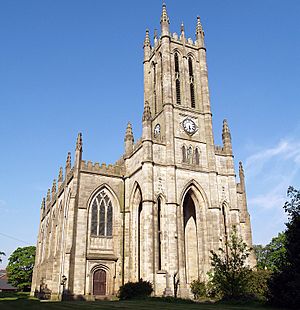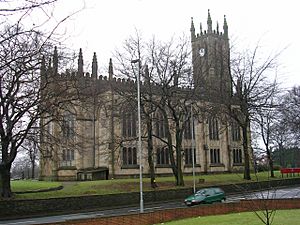All Saints' Church, Stand facts for kids
Quick facts for kids All Saints' Church, Whitefield |
|
|---|---|

West end
|
|
| Lua error in Module:Location_map at line 420: attempt to index field 'wikibase' (a nil value). | |
| OS grid reference | SD 803 060 |
| Location | Church Lane, Stand, Whitefield, Greater Manchester |
| Country | England |
| Denomination | Anglican |
| History | |
| Status | Parish church |
| Architecture | |
| Functional status | Active |
| Heritage designation | Grade I |
| Designated | 15 August 1966 |
| Architect(s) | Charles Barry |
| Architectural type | Church |
| Style | Gothic Revival |
| Groundbreaking | 1821 |
| Completed | 1826 |
| Construction cost | £13,729 |
| Specifications | |
| Materials | Millstone grit |
| Administration | |
| Parish | All Saints, Stand |
| Deanery | Radcliffe and Prestwich |
| Archdeaconry | Bolton |
| Diocese | Manchester |
| Province | York |
All Saints' Church, also known as Stand Church, is an active Anglican church located in Whitefield, England. It is a very important building, listed as Grade I. This means it has special historical and architectural importance. The church is quite tall and stands on high ground, making it easy to spot.
Contents
History of All Saints' Church
All Saints' Church was built between 1821 and 1826. It was one of many "Commissioners' churches" built to celebrate the defeat of Napoleon at the Battle of Waterloo in 1815. The land for the church was given by the Earl of Derby.
The famous architect Sir John Soane was first asked to design the church. He was asked to make it big enough for about 1,800 people and to cost no more than £12,000. Sir John Soane decided not to take the job. Instead, he passed the project to Charles Barry. This church was Charles Barry's very first big project. He later became a very famous architect. The church was officially opened by the Bishop of Chester on 8 September 1826.
Architecture and Design
Outside the Church
All Saints' Church is built from a type of stone called millstone grit. This stone comes from the Pennines mountains. The church's style is described as "fanciful" Gothic. It has a rectangular shape with five sections. At the east end, there is a rounded part called an apse. There is also a porch and a tower at the west end.
The lowest part of the tower forms the porch. You enter through tall, narrow, pointed arches. The tower has openings for bells that look like pairs of tall, thin windows. The sides of the church have two rows of windows. Both the tower and the main part of the church have battlements at the top. These look like the tops of old castles. They also have decorative stone points called crocketed pinnacles.
Inside the Church
Inside, there are balconies on three sides. These balconies are held up by slender pillars. The ceilings are made of plaster and are shaped like vaults. The altar, which is the table used for services, and the screen around it were added in 1921. The seats for the choir and other side screens were added in 1937. All these parts were designed by architects named Austin and Paley.
The beautiful stained glass in the east window was made in 1841 by D. Evans. Other windows have stained glass by different artists. One window from 1921 was made by A. L. Moore. There are also monuments inside, including one from 1826 by Sievier. It shows a lady lying on a long chair.
Church Organ and Bells
The church's first organ was built in 1827. It was located in the west balcony. In 1880, it was moved to the north side of the church. This original organ was removed in 1957. The church now has a different organ with three keyboards, called manuals. This organ was made by Charles A. Smethurst. It was updated in 1997 by Nicholson of Worcester.
The church also has a set of eight bells. All these bells were made in 1912 by Gillett and Johnston. In the 1930s, the church had a long project to decorate and refurnish the main worship area. This project finished in 1937 with new choir stalls, an organ screen, and desks for the clergy.
See also
- List of churches in Greater Manchester
- Grade I listed churches in Greater Manchester
- Listed buildings in Whitefield, Greater Manchester
- List of Commissioners' churches in Northeast and Northwest England


